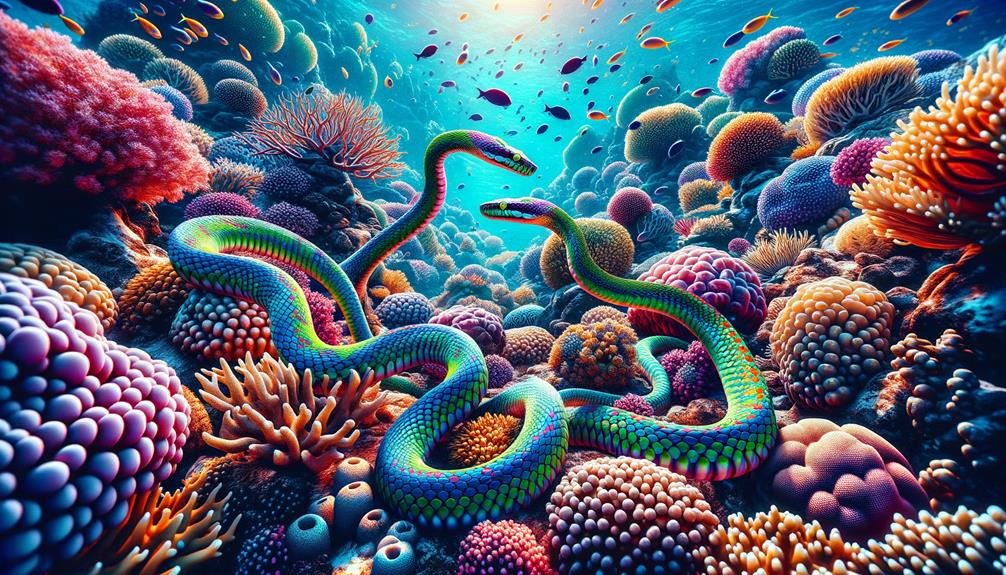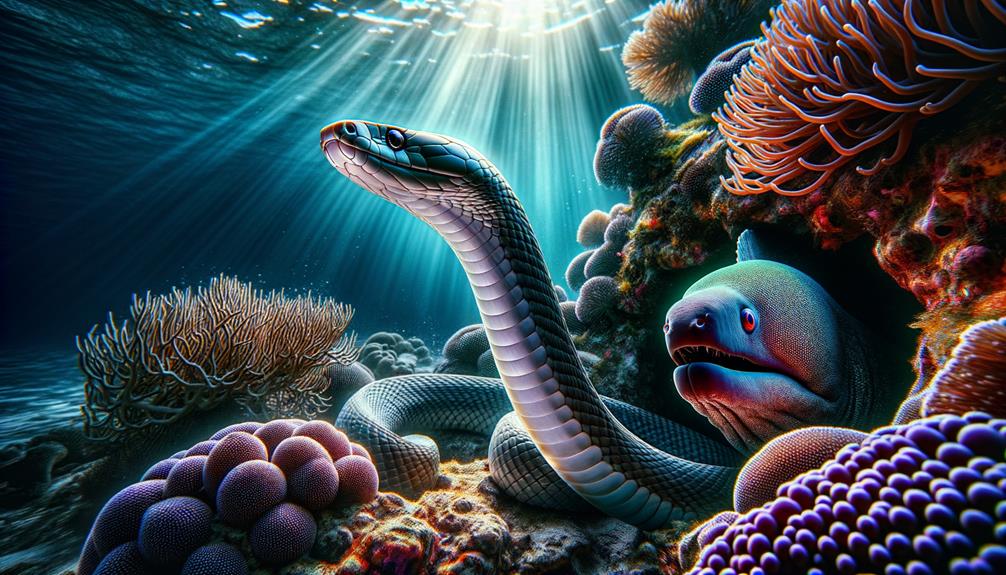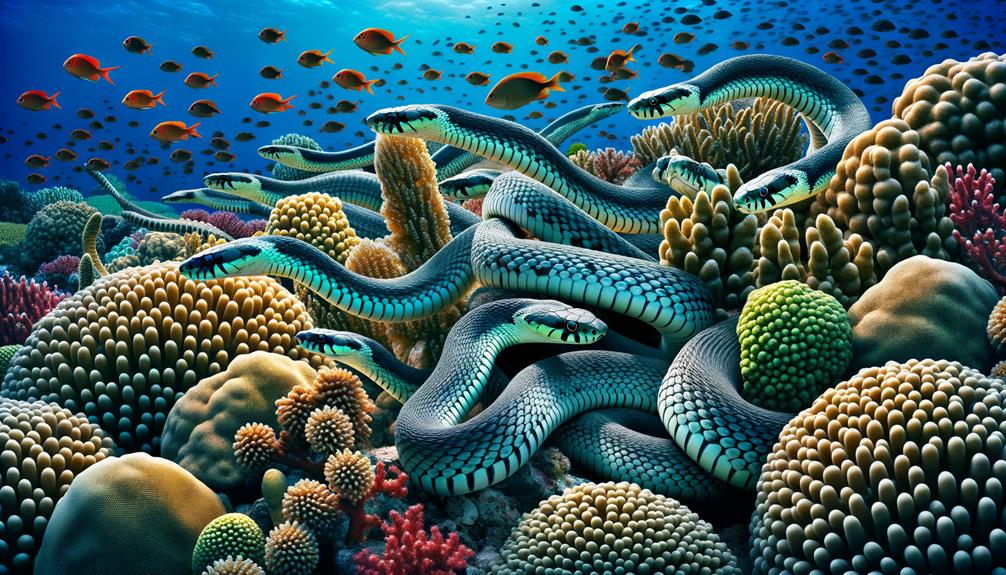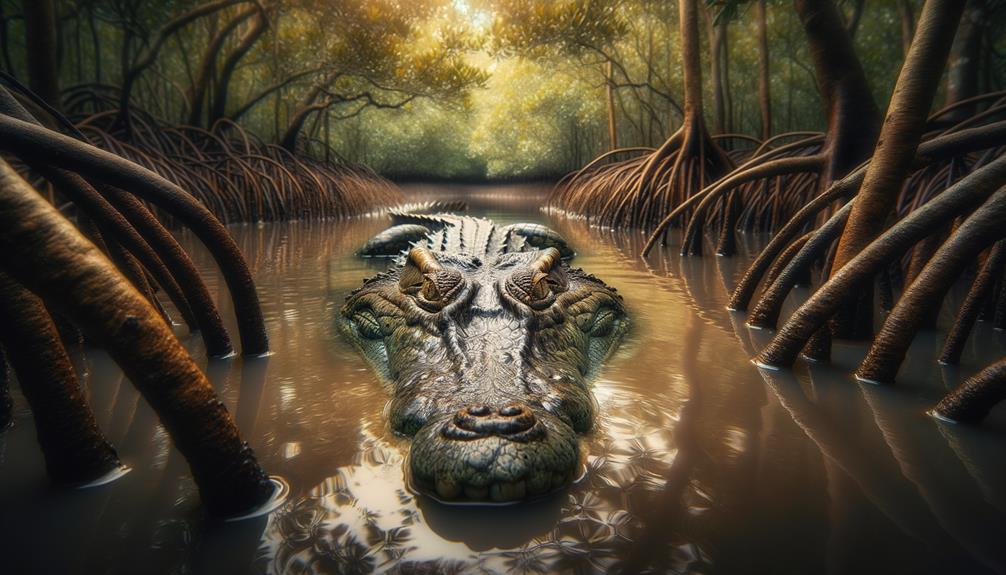Watching sea snakes cruise through coral reefs is a sight to behold. These skilled hunters move with grace and precision, their sleek bodies perfectly suited for navigating the maze-like structures of the reef. Their small eyes and nostrils positioned on top of their heads are ideal adaptations for this environment, letting them hunt effectively and breathe while submerged. These serpents often go after eels, which is fascinating given how sneaky and quick eels can be. It makes you wonder: how do sea snakes manage to catch such slippery prey, and what part does their venom play in this underwater cat-and-mouse game?
Hunting Techniques
Sea snakes are top-notch hunters in coral reefs, thanks to their special skills and adaptations. Take the banded sea kraits, for example. These marine reptiles have an amazing sense of smell, which helps them find eels and other prey hiding in the reef's nooks and crannies. They can pick up even the tiniest whiff of their next meal.
These snakes swim smoothly through the water, sneaking up on their targets without making a fuss. Once they spot their prey, they strike lightning-fast, injecting venom that quickly stops the victim from escaping. Then, they gulp it down whole.
One of the tricks up their scaly sleeves is their ability to stay underwater for a long time – sometimes half an hour or more. This gives them plenty of time to search every crack and crevice where their food might be hiding. Over time, sea snakes have really mastered the art of hunting underwater, making the most of their natural talents and the reef environment.
Adaptations for Reef Life

Sea snakes have developed an impressive array of features that make them well-suited for life in coral reefs. Their flattened tails and sleek bodies give them the agility to weave through the maze-like structures of coral habitats. This streamlined design lets them slip into tight spots and quickly chase down their favorite meals: eels and small fish.
Their eyes are small, which helps protect them from floating debris while still allowing them to see in often-murky reef waters. Nostrils placed on top of their heads let them breathe while staying mostly underwater, making it harder for predators to spot them.
These snakes also have keen senses that help them hunt. They can feel sound vibrations and use their sense of smell to locate prey hiding in coral nooks and crannies. Their smooth, gliding movements through coral formations give them an edge in catching their next meal.
Regular skin shedding is another key part of their reef life. This process helps remove algae and barnacles that might slow them down, keeping their bodies sleek for efficient swimming in the vibrant but challenging coral reef environment.
Breathing and Diving

Sea snakes, remarkable creatures of the reef, have a unique relationship with air and water. As air-breathing reptiles, they must surface regularly, much like their sea turtle cousins. Yet, these agile swimmers can hold their breath for up to half an hour while hunting among the coral.
Their impressive diving abilities allow them to plunge over 75 meters deep, searching the nooks and crannies where their favorite prey, eels, often hide. This underwater stamina is crucial to their hunting tactics. Each time they submerge, sea snakes use their flattened tails to glide smoothly through the water with minimal effort.
Watching a sea snake in its element is truly something to behold. They move with incredible precision, their bodies perfectly suited to life beneath the waves. These adaptations ensure they can stay underwater for long stretches, giving them an edge in the hunt. The way sea snakes breathe and dive showcases nature's ingenuity, allowing them to thrive in the complex and competitive world of coral reefs.
Interaction With Eels

Banded sea kraits hunt eels on coral and rocky reefs, using their powerful neurotoxin to quickly paralyze their prey. These agile sea snakes navigate the complex underwater maze of coral reefs with ease. They can remain submerged for up to half an hour, giving them plenty of time to track down and catch eels.
There's a clear difference in hunting habits between males and females. The larger females, reaching lengths of 1.3 meters, typically go after bigger conger eels. Males, maxing out at about 75 centimeters, usually target smaller moray eels. This size-based prey selection helps reduce competition between the sexes.
Once a banded sea krait spots its target, it strikes fast, delivering a bite that injects a potent venom. The eel is quickly immobilized, allowing the snake to swallow it whole, thanks to its flexible jaw structure. After a successful hunt, these marine reptiles head back to land to digest their meal. Females can end up three times heavier than males due to their larger prey, showcasing the impressive adaptations of these unique creatures.
Predators and Defense Mechanisms

Banded sea kraits, despite their hunting skills, face their own set of challenges in the ocean. These snakes have to navigate a world full of potential threats, using a range of defense tactics to stay alive.
While their venomous nature keeps most predators at bay, some brave sharks and large fish still pose a risk. To counter these dangers, sea snakes rely on several strategies.
Their strong venom acts as a primary deterrent. The eye-catching black and white stripes serve as a warning sign, effectively advertising their toxic capabilities. Blending into coral reefs helps them avoid detection, while their ability to flatten their bodies allows them to hide in small spaces when danger looms.
Some sea snake species have a unique trick up their sleeves – they wiggle their tails to either lure prey or distract predators, buying themselves precious moments to escape. Their agility in the water also plays a crucial role in evading threats.
These combined tactics ensure that banded sea kraits maintain their status as formidable ocean dwellers, skillfully balancing their roles as both hunter and hunted. Their survival hinges on this delicate equilibrium, showcasing nature's intricate design in action.
Frequently Asked Questions
What Eats Sea Snakes in the Coral Reef?
In the coral reef ecosystem, sea snakes face several dangerous predators. Large fish like sharks, birds of prey such as sea eagles, and even other serpents like sea kraits actively hunt these venomous marine reptiles. Despite their potent venom and ability to hide, sea snakes often fall prey to these skilled hunters. These predators have developed ways to overcome the sea snakes' defenses, making them a part of the complex food web in coral reef environments. The constant threat from these hunters plays a crucial role in shaping sea snake behavior and population dynamics within these vibrant underwater communities.
What Are the Predators of the Sea Snakes?
Several creatures pose a threat to sea snakes in their ocean habitat. Sharks and large fish, including groupers, often hunt these marine reptiles. Sea birds, particularly boobies, also target them as prey. The vulnerable eggs and newly hatched snakes face danger from monitor lizards and various seabirds. Young sea snakes must also contend with larger fish and invertebrates looking for an easy meal. This complex web of predation plays a crucial role in maintaining the balance of marine ecosystems, highlighting the challenges sea snakes face throughout their lives.
Why Do People Hunt Sea Snakes?
Sea snake hunting remains a contentious issue, driven by two main factors: the fashion industry's demand for their skins and the culinary world's appetite for their meat. Luxury brands covet sea snake leather for high-end accessories, while some cultures consider the meat a sought-after dish. This ongoing exploitation has led to a worrying decline in sea snake populations, despite efforts by conservationists to protect these marine reptiles. The challenge lies in balancing human desires with the need to maintain healthy ecosystems, as the loss of sea snakes could have far-reaching consequences for marine biodiversity.
Are Dubois Sea Snakes Aggressive?
Dubois sea snakes rarely show aggression toward people. They tend to bite only when feeling threatened or harassed. These distinctive serpents, known for their eye-catching black and white markings, seamlessly blend into coral reefs. Their presence plays a key role in maintaining the delicate balance of their underwater habitat.



